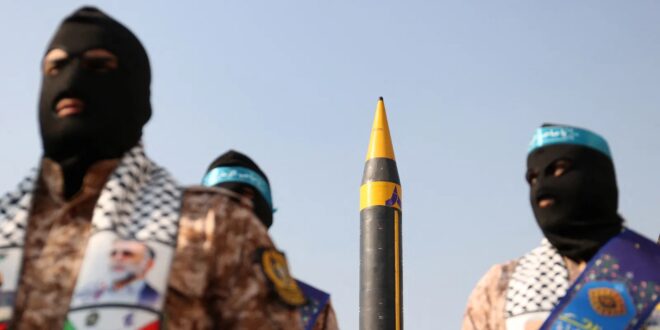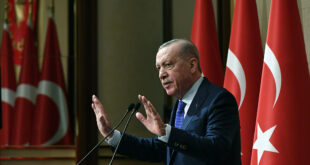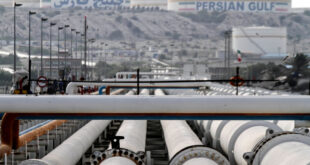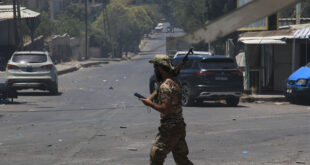The Conflict Has Empowered Tehran—but Also Fueled Its Sense of Vulnerability
Since the start of the war in the Gaza Strip, Iran’s government has sounded bullish, even triumphalist notes. “The Zionist regime’s defeat in this event is not just the defeat of the Zionist regime,” contended Iranian Supreme Leader Ali Khamenei in a speech last month, referencing Israeli setbacks on the battlefield. “It is also the defeat of the U.S.” At the beginning of January, Iranian President Ebrahim Raisi boasted that his country’s enemies “can see Iran’s power, and the whole world knows its strength and capabilities.” And a few days later, an Iranian foreign ministry spokesperson declared that the so-called axis of resistance—the network of partners and proxies Iran backs across the region—is more “coherent, resilient and united than ever.”
It is easy to see why Tehran seems pleased. The war has bogged down its chief regional foe, Israel, in a protracted and perhaps unwinnable conflict. And it has forced Iran’s main global adversary, the United States, to focus on preventing that conflict from escalating, even as it fights off threats from Iran’s allied militias.
Yet for Tehran, the ongoing conflict may not end in anything like the clear-cut victory it has already claimed. Iran wants to be the Middle East’s dominant power, but it has not been willing to capitalize on the war in Gaza by having the axis of resistance open major new fronts against Israel or the United States. Hezbollah—Tehran’s most capable ally—has lobbed missiles at Israel, but it has not sparked an all-out war on the country’s northern border. The Iran-backed Houthi militants in Yemen have repeatedly menaced international shipping and targeted Israel with their missiles and drones, but these attacks have done little to pull Israel out of Gaza. The overall message is clear: Iran can cause chaos, but it is not strong enough to go on a real offensive. It still needs its regional allies primarily to defend its own territory. Tehran may therefore conclude that this conflict has made it look weaker rather than stronger. It may, accordingly, feel more vulnerable.
If that is the case, Tehran could make a final dash for the ultimate deterrent: nuclear weapons. Doing so would have risks, but it might provide Iran with the kind of immunity North Korea and Russia have enjoyed as they confront the West. A nuclear-armed Iran could also be more brazen in unleashing its partners across the Middle East, calculating that the backlash would be limited as its enemies work to avoid Armageddon.
Should Tehran decide to go nuclear, it will be difficult to stop it. The government’s nuclear program is already quite advanced, and it is now subject to limited international oversight. The United States could order a military strike, but even if successful, that strike would, at best, delay Iran’s drive toward weaponization. Yet the consequences of a nuclear Iran are so perilous that it is still worth preventing, which means trying to restart diplomacy.
MIXED BAG
Hamas’s October 7 attack against Israel, in which it unconscionably murdered hundreds of civilians, broke the country’s aura of military invincibility. It marked the first time in decades that outside fighters successfully invaded Israeli territory, and it left many of the country’s residents feeling vulnerable and insecure. It showed that Israel’s intelligence apparatus, long reviled and feared by the country’s adversaries, was not nearly as omnipotent as it seemed.
For Iran, this terrible attack was, almost by definition, something of a victory. Tehran has long been the subject of Israeli covert operations, including the assassination of top Iranian nuclear scientists and military commanders, and Israel has sabotaged Iran’s nuclear and military facilities. Iran thus got to see its principal antagonist immeasurably suffer. When Israel launched its campaign in Gaza, Tehran was able to portray itself as the flag bearer for the newly revived Palestinian cause, bolstering Iran’s reputation across the Middle East. Israel’s reputation, by contrast, tanked, as the war turned Gaza into a humanitarian catastrophe. The image of Israel’s Western patrons has also suffered. To people all over the world, Western criticisms of Russia’s war crimes in Ukraine now seem to reflect a hypocritical double standard.
The war has helped Iran in other ways, too. The conflict has, at a minimum, delayed the normalization of relations between Israel and Saudi Arabia, which could have reisolated Iran following the Chinese-brokered Iranian-Saudi détente last March. The axis of resistance has used the conflict to burnish its capabilities and wide reach. In addition to attacks by Hezbollah and the Houthis, Iraqi and Syrian paramilitary groups have launched well over 150 attacks against U.S. military and diplomatic facilities in Iraq and Syria.
Deterrence is partly a mind game.
Yet beneath this bullish exterior, Tehran has shown signs of strategic weakness. According to The New York Times, U.S. intelligence assessments indicate Iran was surprised by Hamas’s attack, which it viewed as premature. And Iran has done little to assist its supposed ally, even though Hamas dealt Israel its greatest defeat in half a century. The Times also reported that Khamenei ordered his military chiefs to practice “strategic patience” in order to avoid a direct confrontation with the United States. October 7 was, in theory, Iran’s time to shine—a moment when it had a chance to go all out and alter the political order in the Middle East, flexing its hard power via proxies. Instead, its actions have been impetuous and its rewards far from assured.
To some extent, the reluctance to enter the fray in full force makes sense. Under Iran’s strategy, the axis of resistance is primarily aimed at deterring Israel and the United States from attacking Iran itself, something that has not yet happened. But although the Iranian homeland has not been struck by either country (it has been attacked by the Islamic State, or ISIS, and, in a retaliatory operation, by Pakistan), Iranian commanders and their allies have been hit by American and Israeli strikes. According to a Reuters report, for example, Israel killed one of Iran’s most senior commanders in Syria. Four intelligence officers from the Revolutionary Guards were killed in Damascus a few weeks later. Israel also killed a close Hamas contact based in Beirut and a senior Hezbollah commander in southern Lebanon. The United States, meanwhile, targeted a Shiite militia leader in Baghdad and has been bombing the Houthis in Yemen in response to their attacks in the Red Sea. And even if Israel and the United States had conducted no strikes, Iran’s restraint in response to Israel’s invasion of Gaza—relative, at least, to Tehran’s full capacity—would be noteworthy.
Deterrence is partly a mind game in which adversaries must fear not just a state’s capabilities but also a state’s willingness to use them. Iran’s reluctance to sacrifice members of its network for the sake of saving Hamas is, therefore, a sign the country is not the mastermind or behemoth destabilizing the region. Instead, it is a reticent actor on its back foot.
PLAYING WITH FIRE
After U.S. President Joe Biden took office in 2021, Iran and the United States began holding indirect negotiations in hopes of reducing regional tensions, lightening U.S. sanctions, and, critically, constraining Iran’s nuclear program. The talks did not succeed in restoring the 2015 nuclear deal, but by the summer of 2023, they appeared to have reached a stopgap, de-escalatory understanding. Iranian proxies halted attacks against U.S. forces in Iraq and Syria, and Iran slowed its high-level enrichment for the first time since 2021. In exchange, the United States released some frozen Iranian funds. The two sides exchanged some prisoners in September 2023. Building on that progress, Iran and the United States were supposed to return to the negotiating table on October 18 in Oman, where they would start more expansive talks. But that small window of opportunity was shut down the minute Hamas militants paraglided into Israeli territory. With the U.S. entering a presidential election year and the Iranian regime now complicit in two wars against U.S. allies—Israel and Ukraine—there is no real prospect for serious diplomatic engagement.
This breakdown comes as Iran inches ever closer to the ability to produce nuclear weapons. Today, it would take about a month for the country to produce enough enriched nuclear material for an arsenal of four to five nuclear warheads. It could manufacture a deliverable bomb perhaps just a few months later. The exact timing is difficult to predict, in part because the United Nations nuclear watchdog cannot fully monitor Tehran’s nuclear program. Iran no longer complies with the now defunct nuclear deal’s transparency measures, which allowed inspectors to monitor centrifuge production plants and undeclared nuclear facilities. As a result, Tehran can now potentially divert its production of highly enriched uranium to clandestine facilities.
Tehran still has good reasons not to build a nuclear weapon or even to enrich uranium to weapons-grade levels and bar UN inspectors entirely. Merely crossing these thresholds, for instance, could prompt a preventive strike by Israel or the United States. If Iran manages to construct a weapon undetected, it risks triggering a regional nuclear arms race with its Gulf competitors, such as Saudi Arabia. And if Iran goes nuclear, it would likely anger China, far and away Iran’s most critical oil customer and an invaluable diplomatic partner.
To stop a nuclear Iran, the United States has just one real option: diplomacy.
Still, Tehran might decide that the benefits of going nuclear outweigh the risks. Iran has already paid the economic price for nuclear weapons after suffering from years of sanctions. It no longer believes that the West would be willing and able to offer effective and sustainable sanctions relief, even if it were to roll back its nuclear program. And unfortunately, the aftermath of October 7 makes nuclearization more likely. Tehran’s cautious response has exposed its vulnerability, weakening the credibility of its regional deterrence. Iranian leaders may see acquiring nuclear weapons as a way to gain newfound assurance that it won’t be attacked by Israel or the United States—freeing the axis of resistance to wreak far more havoc. Plus, Iranian officials who want the country to get a nuclear weapon (Tehran itself is likely divided on whether to go nuclear) could view this as a moment of great opportunity. Iran’s rivals, after all, are distracted by the wars in Gaza and Ukraine, competition with China, and elections.
Even if the United States and its allies do catch Iran trying to go nuclear, they have no good way to stop it. They could attempt to take out some facilities or expertise with military strikes. But Iran and its allies would respond with attacks on U.S. assets, and Iran now has enough knowledge and talent that strikes alone would only delay Iranian nuclearization. If Tehran were to disperse its highly enriched uranium to secret facilities for further enrichment and weapons manufacturing, Washington would have to either carpet bomb the entire country or attempt regime change, either by invasion or internal revolt. None of these options seem plausible. Iran has a population nearly twice the size of Iraq’s, a landmass nearly four times as large, and a far more powerful military. The United States would struggle mightily to flatten the country or to take and hold it. The humanitarian consequences of an extended bombing campaign or an invasion would be ghastly. And as the Iranian regime’s crackdowns against repeated protests illustrated, Tehran retains a brutally effective grip on power.
That leaves the United States with just one real option: diplomacy. It is the only thing that has curtailed Iran’s nuclear program in the past, and it is the only thing that stands a chance of doing so today. “Diplomacy, diplomacy, diplomacy, this is what we need,” declared the UN nuclear czar, Rafael Grossi, while speaking about Iran in January. “We need to prevent the situation deteriorating to a degree where it would be impossible to retrieve it.” But to avoid such a deterioration, countries need a policy that goes beyond just deterring Tehran from further escalating its nuclear program. That policy would, even in the best case, still leave Iran in a worryingly advanced position. Instead of merely focusing on not crossing the precipice, policymakers should aim to move away from it.
Restarting talks will not be popular or easy in key Western capitals, where Iran is understandably more reviled than it has been in decades. It may also be hard to sell in Tehran, where policymakers are increasingly adversarial. But an atomic Iran could make an already volatile region a whole lot more explosive, and even if the odds are long, the West should still push Tehran to use its nuclear program as leverage at the negotiating table—rather than as a deterrent on the battlefield. As a 1970s antinuclear slogan put it: Better active today than radioactive tomorrow.
 Eurasia Press & News
Eurasia Press & News




